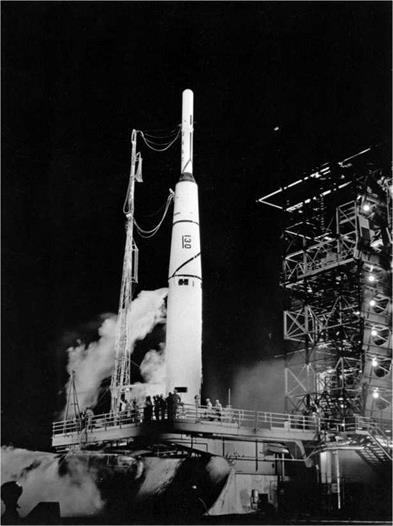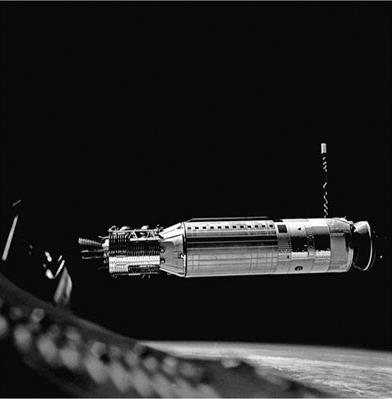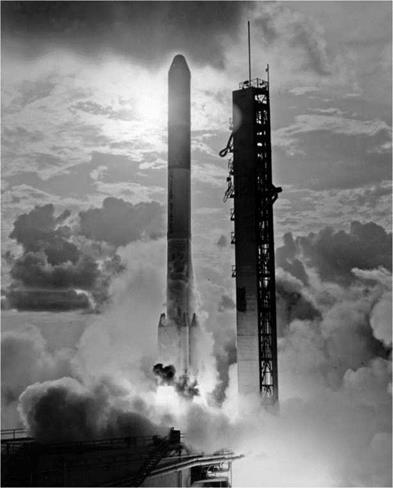The Thor and Delta Family of Launch Vehicles, 1958-90
The Thor missiles did not remain in operational use very long, but even before the air force retired them in 1963, it had begun to use the Thor’s airframe and propulsive elements (including its vernier engines) as the first stages of various launch vehicles. With a series of upratings and modifications, the Thor remained in use with such upper stages as the Able, Able-Star, Agena, Burner I, Burner II, and Burner IIA until 1980. In addition, NASA quickly chose the Thor as the first stage of what became its Thor-Delta (later, just Delta) launch-vehicle family, which has had an even longer history than the air force’s Thor series. The Delta launch vehicles initially drew upon Vanguard upper stages, as did the Thor-Able used by the air force.10
Throughout its history, the Delta evolved by uprating existing components or adopting newer ones that had proven themselves. It used a low-risk strategy to improve its payload capacity through the Delta II at the end of the period covered by this history. But it did not stop there, evolving through a Delta III, first launched (unsuccessfully) in 1998, and a Delta IV that finally had its successful first launch on November 20, 2002. (To be sure, the Delta IV used an entirely new first stage, making it in some senses a new launch vehicle, but the design emphasized reliability and low cost, hallmarks of the Delta program from the beginning.) The unsuccessful first (and second) launch(es) of the Delta III and numerous delays in the launch of Delta IV because of both software and hardware problems 54 suggested, however, that the design of new launch vehicles was still Chapter 2 not something engineers had “down to a science," even in the 21st century.11
For the Able upper stage, the air force and its contractors used many features of the Vanguard second stage but added a control compartment, skirts and structural elements to mate it with the Thor, a tank venting and pressurization safety system, new electrical components, and a roll-control system. Used for reentry testing, the first Thor-Able failed because of a faulty turbopump in the Thor, but the second launch on July 9, 1958, was successful.12
|

Succeeding versions of Thor-Able modified both second and third stages of Vanguard. The final Thor-Able launch on April 1, 1960, placed the Tiros 1 meteorological satellite in orbit. In the 16 Thor-Able launches, all of the stages worked satisfactorily on 10 of the missions, whereas at least one stage failed or was only partly successful on 6 flights. Although this was only a 62.5 percent success rate, it was sufficiently good for this early period that the air force could refer to Thor-Able as “an extremely capable and reliable vehicle combination."13
 Long before the final launch of the Thor-Able, nevertheless, the Department of Defense’s Advanced Research Projects Agency had
Long before the final launch of the Thor-Able, nevertheless, the Department of Defense’s Advanced Research Projects Agency had
issued an order on July 1, 1959, calling for the development of the Able-Star upper stage, derived from the Able but possessing two and one half times its total impulse plus the capability to shut down its propulsion in space, coast, and restart. This ability would permit a more precise selection of the orbit for a satellite than was possible before. Once Able-Star became operational in January 1960, it effectively replaced the Able as an upper stage.14
The Able-Star engine was a derivative of the several Able engines except that it had the added restart capability plus the capacity to provide attitude control during coasting periods and to burn longer than the earlier engines. Following a rapid but not unproblematic development, an Able-Star upper stage on a Thor booster launched the Transit 1B navigation satellite on April 13, 1960, marking the first programmed restart of a rocket engine in flight. Although the coast attitude-control system worked, a malfunction in the Able – Star ground guidance system resulted in a still-useful elliptical rather than a circular orbit. Sloshing in stage-two propellant tanks for Transit 2A—launched on June 22, 1960—again produced an elliptical orbit because it caused roll forces that the guidance/control system could not overcome. Again the orbit was useful. Following placement of anti-slosh baffles in both Able-Star propellant tanks, the Thor booster failed on the attempted launch of Transit 3A, November 30, 1960. Then on February 21, 1961, a Thor/Able-Star failed to place Transit 3B in a usable orbit because a part malfunctioned in the programmer before it could signal the restart of stage two from its coasting orbit. Substantially the same launch vehicle as on Transit 3A successfully launched Transit 4A into a nearly circular orbit on June 28, 1961.15 Through August 13, 1965, including the launches just discussed, the Thor/Able-Star completed a total of 20 missions with 5 failures, for a success rate of 75 percent. Quite successful for an early launch vehicle, the Thor/Able-Star also marked a step forward in satellite-launching capability.16
Even before the first launch of Thor/Able-Star, the air force had 56 begun using an Agena upper stage with the Thor, and this combi – Chapter 2 nation became a preferred choice for a great many often-classified missions, including those to place a family of reconnaissance satellites in orbit under what began as the WS-117L program. Initially, the Agena upper stages flew on basic Thors, but in three versions from A to D (without a C), the Agena also operated with uprated Thors, Atlases, and Titan IIIs to orbit a great many military and NASA spacecraft until 1987.17
The air force began developing the Agena in July 1956. On October 29, 1956, that service selected Lockheed Missile Systems
Division as the prime contractor for both the WS-117L reconnaissance satellite system and an associated upper stage that became the Agena. The engine for the Lockheed upper stage was a modified version of the Hustler propulsion unit (model 117) that Bell Aerospace had developed for the B-58 bomber’s air-to-surface missile, designated the Powered Disposable Bomb Pod. The air force canceled the missile, but Lockheed contracted with Bell in the fall of 1957 to develop the engine for Agena.18
One change from the Hustler engine was the addition of gim – balling. Another was a nozzle closure to ensure that the Agena started in space after cutoff of the first-stage engine. The Agena stage with this engine, known as the Bell 8001, flew only once, on February 28, 1959, for the launch of Discoverer 1 by a Thor-Agena A. (Discoverer was the name publicly released for the secret Corona reconnaissance satellites, which had separated from the WS-117L program by this time.) Accounts differ as to the outcome of this first launch into a polar orbit from Vandenberg AFB, California—some claiming the launch itself was successful, and others that it was not.19
The Agena nevertheless had an extensive career as an upper stage. The Agena A operated successfully on 78 percent of its 14 launches by September 13, 1960 (all by Thors; all but one with a new Bell model 8048 engine for the Agena), with 3 failures. A more capable Thor-Agena B appears to have had 39 successful performances on 48 launches from October 26, 1960, to May 15, 1966, an 81 percent success rate, mostly launching Corona satellites. With a thrust- augmented Thor, the Agena B could launch much heavier satellites, added thrust coming from solid-propellant strap-on boosters.20
 Meanwhile, in the fall of 1959 Bell began designing the engine for the Agena D, which became the standard Agena propulsion unit. From June 28, 1962, to May 25, 1972, a large number of Thor-Agena D launches occurred, but because of the classified nature of many of the payloads, a reliable and precise tally is not available. During this period, the basic booster changed from the thrust-augmented to the long-tank, thrust-augmented Thor (called Thorad) with increased burning time and improved strap-on boosters.21
Meanwhile, in the fall of 1959 Bell began designing the engine for the Agena D, which became the standard Agena propulsion unit. From June 28, 1962, to May 25, 1972, a large number of Thor-Agena D launches occurred, but because of the classified nature of many of the payloads, a reliable and precise tally is not available. During this period, the basic booster changed from the thrust-augmented to the long-tank, thrust-augmented Thor (called Thorad) with increased burning time and improved strap-on boosters.21
Another series of upper stages used with the Thor first stage included Burner I, Burner II, and Burner IIA. Burner I actually bore little relation to Burners II and IIA. Information about it is sparse, but sources refer to it as the Altair, a derivative of the Vanguard third stage developed by Hercules Powder Company at the Allegany Ballistics Laboratory. The first launch of the Thor-Burner I occurred on January 18, 1965, with the last one taking place on March 30, 1966. There apparently were only four such launches, all from Van-
An Agena upper stage, used also for many satellite launches, serving here as the Gemini 8 target vehicle for docking. (Photo courtesy of NASA)
![]()
 denberg AFB into sun-synchronous orbits, one of them a mission failure. The spacecraft were classified at the time but appear to have been Block 4A Defense Satellite Applications Program weather satellites used to inform the U. S. military of weather conditions for launching reconnaissance satellites and other defense purposes, such as mission planning during the conflict in Vietnam. In 1973, the program became the Defense Meteorological Satellite Program (DMSP) and was no longer classified.22
denberg AFB into sun-synchronous orbits, one of them a mission failure. The spacecraft were classified at the time but appear to have been Block 4A Defense Satellite Applications Program weather satellites used to inform the U. S. military of weather conditions for launching reconnaissance satellites and other defense purposes, such as mission planning during the conflict in Vietnam. In 1973, the program became the Defense Meteorological Satellite Program (DMSP) and was no longer classified.22
58 Burner I was little used because of the development of Burner Chapter 2 II. Conceiving a need for a guided upper stage that would be low in cost and usable with more than one first-stage vehicle, on September 2, 1961, the air force’s Space Systems Division (SSD) awarded study contracts to the Boeing Company and Ling-Temco-Vought, Inc., pursuant to development of what became Burner II. As a result of its initial work, Boeing won a fixed-price contract on April 1, 1965, to provide one ground-test and three flight versions of the new upper stage. By September 15, Maj. Gen. Ben I. Funk, commander of SSD, could announce the development of the new stage, which
became the smallest maneuverable upper-stage vehicle in the air force inventory.23
The primary propulsion for Burner II came from the Thiokol TE- M-364-2 (Star 37B) motor, a spherical design promoted by NASA engineer Guy Thibodeaux. Between September 15, 1966, and February 17, 1971, Thor-Burner II vehicles launched four Block 4A, three Block 4B, and three Block 5A Defense Satellite Applications Program weather satellites from the Western Test Range. During this same general period, the Thor-Burner II also launched scientific satellites as part of the Department of Defense’s Space Experiments Support Program managed by SSD.24
The Block 5B versions of the Defense Satellite Applications Program weather satellites were about twice as heavy as the 5A versions, necessitating increased thrust for Burner II. So the air force’s Space and Missile Systems Organization (created July 1, 1967, to bring the SSD and its sister Ballistics Systems Division into a single organization headquartered in Los Angeles at the former SSD location) contracted with Boeing for an uprated Burner II that became Burner IIA. Boeing did the uprating with a minimum of modifications by adding a Thiokol TE-M-442-1 motor to form a second upper stage. With the Burner IIA, a Thor first stage launched five Block 5B and two Block 5C meteorological satellites (in what became the DMSP) from October 14, 1971, to May 24, 1975. A final Thor-Burner IIA launch on February 18, 1976, failed because the Thor prematurely ceased firing. This last use of the Burner IIA did not spell the end of the DMSP program, however, because a Thor coupled with a Thiokol TE-M-364-15 (Star 37S) motor that had a titanium case (rather than the steel used on the Star 37B) launched 4 improved Block 5D weather satellites between Sept ember 11, 1976, and June 6, 1979. Then Atlas Es and Titan IIs launched 10 more DMSP satellites by 1999.25
 A final major Thor launch vehicle was the Thor-Delta. Whereas the other Thor-based launch vehicles were primarily air force assets sometimes used by NASA, Delta was a NASA-developed space – launch vehicle used on occasion by the air force until near the end of the period covered by this book, when the air force began to make extensive use of Delta IIs. Since it was conceived by NASA in 1959 as an interim vehicle to lift medium payloads by using existing technology, modified only as needed for specific missions, Delta has enjoyed a remarkably long career, attesting to its success.26
A final major Thor launch vehicle was the Thor-Delta. Whereas the other Thor-based launch vehicles were primarily air force assets sometimes used by NASA, Delta was a NASA-developed space – launch vehicle used on occasion by the air force until near the end of the period covered by this book, when the air force began to make extensive use of Delta IIs. Since it was conceived by NASA in 1959 as an interim vehicle to lift medium payloads by using existing technology, modified only as needed for specific missions, Delta has enjoyed a remarkably long career, attesting to its success.26
The initial idea for Thor-Delta apparently came from Milton Rosen. He was working at NASA Headquarters in the Office of Space Flight Development, headed by Abe Silverstein. His imme-
diate supervisor was Abraham Hyatt, who had become the assistant director for propulsion following a decade of work at the navy’s Bureau of Aeronautics. At Silverstein’s behest, Rosen worked with Douglas Aircraft Company to develop the vehicle. Using components already proven in flight, NASA and Douglas eliminated the need for developmental flights. Their contract set a very ambitious goal (for 1959) of an initial 50 percent reliability with a final rate of 90 percent.27
An important asset in Delta’s development consisted of the personnel from the Vanguard program, including Rosen, who brought their experience to decision-making positions at the new Goddard Space Flight Center within NASA, as well as at NASA Headquarters. At Goddard, William R. Schindler, who had worked on Vanguard, headed a small technical group that provided direction and technical monitoring for the Delta program, which initially borrowed technology from the Vanguard, Thor-Able, and Titan programs. On November 24, 1962, NASA converted this technical direction to formal project management for Delta.28
On May 13, 1960, an attempt to launch the spherical, passive reflector satellite Echo with the first Thor-Delta failed when the third-stage propellants did not ignite because a small chunk of solder in a transistor broke loose in flight and shorted out a semiconductor that had passed all of its qualification tests. A similar but less costly problem with another transistor on the third Delta launch led NASA to change its specifications and testing of such components. Meanwhile, on August 12, 1960, the second Delta launch successfully placed Echo 1 into orbit. And the remainder of the original 12 Deltas all had successful launches of a variety of payloads from the Tiros 2 through 6 weather satellites to the Telstar 1 communications satellite, the first commercial spacecraft launched by NASA (on July 10, 1962, the last of the original 12 launches by a Delta).29
From this beginning, the Delta went through a long and complicated series of modifications and upgrades. The initial Delta could 60 launch 100 pounds of payload to geostationary (also called geosyn – Chapter 2 chronous) transfer orbit. Starting in 1962, Delta evolved through a series of models with designations such as A, B, C, D, E, J, L, M, M-6, N, 900, 904, 2914, 3914, 3910/PAM (for Payload Assist Module), 3920/PAM, 6925 (Delta II), and 7925 (also a Delta II), the last of them introduced in 1990. The payload capabilities of these versions of the vehicle increased, at first gradually and then more rapidly, so that the 3914 introduced in 1975 could lift 2,100 pounds to geostationary transfer orbit and the 7925 could lift 4,010 pounds (40.1 times the original capability).30
FIG. 2.6



A Delta 1910 vehicle launching Orbiting Solar Observatory 8 on June 21, 1975, showing the Castor II strap-on boosters at the base of the vehicle to add to the thrust. (Photo courtesy of NASA)
as borrowers of new technology from other programs, they experienced fewer birth pangs than other missiles and rockets, showing the value of shared information. They nevertheless did experience some unexpected problems that required redesign. But by (mostly) using components already tested and proven, the Delta achieved a high reliability that made it an enduring member of the launch – vehicle family. From an interim launch vehicle in 1959, it became one of the few that lasted into the 21st century, a distinction shared with the Atlas family.32










